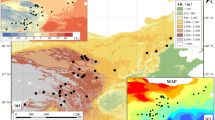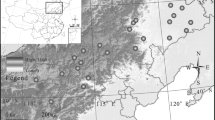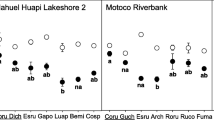Abstract
Foliar nitrogen isotope (δ15N) composition patterns have been linked to soil N, mycorrhizal fractionation, and within-plant fractionations. However, few studies have examined the potential importance of the direct foliar uptake of gaseous reactive N on foliar δ15N. Using an experimental set-up in which the rate of mycorrhizal infection was reduced using a fungicide, we examined the influence of mycorrhizae on foliar δ15N in potted red maple (Acer rubrum) seedlings along a regional N deposition gradient in New York State. Mycorrhizal associations altered foliar δ15N values in red maple seedlings from 0.06 to 0.74 ‰ across sites. At the same sites, we explored the predictive roles of direct foliar N uptake, soil δ15N, and mycorrhizae on foliar δ15N in adult stands of A. rubrum, American beech (Fagus grandifolia), black birch (Betula lenta), and red oak (Quercus rubra). Multiple regression analysis indicated that ambient atmospheric nitrogen dioxide (NO2) concentration explained 0, 69, 23, and 45 % of the variation in foliar δ15N in American beech, red maple, red oak, and black birch, respectively, after accounting for the influence of soil δ15N. There was no correlation between foliar δ13C and foliar %N with increasing atmospheric NO2 concentration in most species. Our findings suggest that total canopy uptake, and likely direct foliar N uptake, of pollution-derived atmospheric N deposition may significantly impact foliar δ15N in several dominant species occurring in temperate forest ecosystems.





Similar content being viewed by others
References
Aber JD (1992) Nitrogen cycling and nitrogen saturation in temperate forest ecosystems. Trends Ecol Evol 7:220–224
Ammann M, Siegwolf R, Pichlmayer F, Suter M, Saurer M, Brunold C (1999) Estimating the uptake of traffic-derived NO2 from 15N abundance in Norway spruce needles. Oecologia 118:124–131
Amundson R, Austin AT, Schuur EAG, Yoo K, Matzek V, Kendall C, Uebersax A, Brenner D, Baisden WT (2003) Global patterns of the isotopic composition of soil and plant nitrogen. Global Biogeochem Cycle 17:11
Bobbink R, Hicks K, Galloway J, Spranger T, Alkemade R, Ashmore M, Bustamante M, Cinderby S, Davidson E, Dentener F, Emmett B, Erisman JW, Fenn M, Gilliam F, Nordin A, Pardo L, De Vries W (2010) Global assessment of nitrogen deposition effects on terrestrial plant diversity: a synthesis. Ecol Appl 20:30–59
Craine JM, Elmore AJ, Aidar MPM, Bustamante M, Dawson TE, Hobbie EA, Kahmen A, Mack MC, McLauchlan KK, Michelsen A, Nardoto GB, Pardo LH, Penuelas J, Reich PB, Schuur EAG, Stock WD, Templer PH, Virginia RA, Welker JM, Wright IJ (2009) Global patterns of foliar nitrogen isotopes and their relationships with climate, mycorrhizal fungi, foliar nutrient concentrations, and nitrogen availability. New Phytol 183:980–992
Dawson TE, Mambelli S, Plamboeck AH, Templer PH, Tu KP (2002) Stable isotopes in plant ecology. Annu Rev Ecol Syst 33:507–559
Driscoll CT, Whitall D, Aber J, Boyer E, Castro M, Cronan C, Goodale CL, Groffman P, Hopkinson C, Lambert K, Lawrence G, Ollinger S (2003) Nitrogen pollution in the northeastern United States: sources, effects, and management options. Bioscience 53:357–374
Ehleringer JR (1993) Variation in leaf-carbon isotope discrimination in Encelia farinosa—implications for growth, competition, and drought survival. Oecologia 95:340–346
Elliott EM, Kendall C, Wankel SD, Burns DA, Boyer EW, Harlin K, Bain DJ, Butler TJ (2007) Nitrogen isotopes as indicators of NOx source contributions to atmospheric nitrate deposition across the Midwestern and Northeastern United States. Environ Sci Technol 41:7661–7667
Elliott EM, Kendall C, Boyer EW, Burns DA, Lear GG, Golden HE, Harlin K, Bytnerowicz A, Butler TJ, Glatz R (2009) Dual nitrate isotopes in dry deposition: utility for partitioning NOx source contributions to landscape nitrogen deposition. J Geophys Res Biogeol 41(22):7661–7667
Emmett BA, Kjonaas OJ, Gundersen P, Koopmans C, Tietema A, Sleep D (1998) Natural abundance of 15N in forests across a nitrogen deposition gradient. For Ecol Manag 101:9–18
Evans RD (2001) Physiological mechanisms influencing plant nitrogen isotope composition. Trends Plant Sci 6:121–126
Freyer HD (1991) Seasonal variation of 15N/14N ratios in atmospheric nitrate species. Tellus B 43:30–44
Galloway JN, Aber JD, Erisman JW, Seitzinger SP, Howarth RW, Cowling EB, Cosby BJ (2003) The nitrogen cascade. Bioscience 53:341–356
Galloway JN, Dentener FJ, Capone DG, Boyer EW, Howarth RW, Seitzinger SP, Asner GP, Cleveland CC, Green PA, Holland EA, Karl DM, Michaels AF, Porter JH, Townsend AR, Vorosmarty CJ (2004) Nitrogen cycles: past, present, and future. Biogeochemistry 70:153–226
Galloway JN, Townsend AR, Erisman JW, Bekunda M, Cai ZC, Freney JR, Martinelli LA, Seitzinger SP, Sutton MA (2008) Transformation of the nitrogen cycle: recent trends, questions, and potential solutions. Science 320:889–892
Ganade G, Brown VK (1997) Effects of below-ground insects, mycorrhizal fungi and soil fertility on the establishment of Vicia in grassland communities. Oecologia 109:374–381
Gange AC, Brown VK, Farmer LM (1990) A test of mycorrhizal benefit in an early successional plant community. New Phytol 115:85–91
Gange AC, Brown VK, Farmer LM (1992) Effects of pesticides on germination of weed seeds: implications for manipulative experiments. J Appl Ecol 29:303–310
Gange AC, Brown VK, Sinclair GS (1993) Vesicular-arbuscular mycorrhizal fungi: a determinant of plant community structure in early succession. Funct Ecol 7:616–622
Garten CT, Vanmiegroet H (1994) Relationships between soil nitrogen dynamics and natural 15N abundance in plant foliage from Great Smoky Mountains national park. Can J For Res 24:1636–1645
Gebauer G, Schulze ED (1991) Carbon and nitrogen isotope ratios in different compartments of a healthy and a declining Picea abies forest in the Fichtelgebirge, NE Bavaria. Oecologia 87:198–207
Guerrieri R, Mencuccini M, Sheppard LJ, Saurer M, Perks MP, Levy P, Sutton MA, Borghetti M, Grace J (2011) The legacy of enhanced N and S deposition as revealed by the combined analysis of δ13C, δ18O and δ15N in tree rings. Glob Chang Biol 17:1946–1962
Handley LL, Raven JA (1992) The use of natural abundance of nitrogen isotopes in plant physiology and ecology. Plant Cell Environ 15:965–985
Handley LL, Scrimgeour CM, Raven JA (1998) 15N at natural abundance levels in terrestrial vascular plants: a precise. In: Griffiths H (ed) Stable isotopes: integration of biological, ecological and geochemical processes. Bios Scientific Publishers, Oxford, pp 89–98
Heaton THE (1990) 15N/14N ratios of NOx from vehicle engines and coal-formed power stations. Tellus B 42:304–307
Hereid DP, Monson RK (2001) Nitrogen oxide fluxes between corn (Zea mays L.) leaves and the atmosphere. Atmos Environ 35:975–983
Hobbie EA, Hobbie JE (2008) Natural abundance of 15N in nitrogen-limited forests and tundra can estimate nitrogen cycling through mycorrhizal fungi: a review. Ecosystems 11:815–830
Hobbie EA, Ouimette AP (2009) Controls of nitrogen isotope patterns in soil profiles. Biogeochemistry 95:355–371
Hobbie EA, Macko SA, Williams M (2000) Correlations between foliar δ15N and nitrogen concentrations may indicate plant-mycorrhizal interactions. Oecologia 122:273–283
Högberg P (1997) Tansley review no. 95—15N natural abundance in soil-plant systems. New Phytol 137:179–203
Kahmen A, Wanek W, Buchmann N (2008) Foliar δ15N values characterize soil N cycling and reflect nitrate or ammonium preference of plants along a temperate grassland gradient. Oecologia 156:861–870
Li DJ, Wang XM (2008) Nitrogen isotopic signature of soil-released nitric oxide (NO) after fertilizer application. Atmos Environ 42:4747–4754
Lovett GM, Traynor MM, Pouyat RV, Carreiro MM, Zhu WX, Baxter JW (2000) Atmospheric deposition to oak forests along an urban–rural gradient. Environ Sci Technol 34:4294–4300
Morikawa H, Higaki A, Nohno M, Takahasi M, Kamada M, Nakata M, Toyohara G, Okamura Y, Matsui K, Kitani S, Fujita K, Irifune K, Goshima N (1998) More than a 600-fold variation in nitrogen dioxide assimilation among 217 plant taxa. Plant Cell Environ 21:180–190
Nadelhoffer KJ, Fry B (1994) Nitrogen isotopes in forest ecosystems. In: Lajtha K, Michener RH (eds) Stable isotopes in ecology and environmental science. Blackwell, Oxford, pp 22–44
Pardo L, Nadelhoffer K (2010) Using nitrogen stable isotope ratios to assess terrestrial ecosystems at regional and global scales. In: West JB, Bowen GJ, Dawson TE, Tu KP (eds) Isoscapes: understanding movement, pattern, and process on earth through isotope mapping. Springer, New York, pp 221–249
Pardo LH, Hemond HF, Montoya JP, Fahey TJ, Siccama TG (2002) Response of the natural abundance of 15N in forest soils and foliage to high nitrate loss following clear-cutting. Can J For Res 32:1126–1136
Pearson J, Wells DM, Seller KJ, Bennett A, Soares A, Woodall J, Ingrouille MJ (2000) Traffic exposure increases natural 15N and heavy metal concentrations in mosses. New Phytol 147:317–326
Robinson D (2001) δ15N as an integrator of the nitrogen cycle. Trends Ecol Evol 16:153–162
Saurer M, Cherubini P, Ammann M, De Cinti B, Siegwolf R (2004) First detection of nitrogen from NOx in tree rings: a 15N/14N study near a motorway. Atmos Environ 38:2779–2787
Schaberg PG, DeHayes DH, Hawley GJ, Murakami PF, Strimbeck GR, McNulty SG (2002) Effects of chronic N fertilization on foliar membranes, cold tolerance, and carbon storage in montane red spruce. Can J For Res 32:1351–1359
Schlesinger WH (2009) On the fate of anthropogenic nitrogen. Proc Natl Acad Sci USA 106:203–208
Siegwolf RTW, Matyssek R, Saurer M, Maurer S, Gunthardt-Goerg MS, Schmutz P, Bucher JB (2001) Stable isotope analysis reveals differential effects of soil nitrogen and nitrogen dioxide on the water use efficiency in hybrid poplar leaves. New Phytol 149:233–246
Sievering H, Tomasewski T, Torizzo J (2007) Canopy uptake of atmospheric N deposition at a conifer forest Part I. Canopy N budget, photosynthesis efficiency and net ecosystem exchange. Tellus B 59:483–492
Smart DR, Bloom AJ (1993) The relationship between kinetics of NH4 + and NO3 − absorption and growth in cultivated tomato (Lycopersicon esculentum Mill cv. T5). Plant Cell Environ 16:259–267
Sparks JP (2009) Ecological ramifications of the direct foliar uptake of nitrogen. Oecologia 159:1–13
Sparks JP, Monson RK, Sparks KL, Lerdau M (2001) Leaf uptake of nitrogen dioxide (NO2) in a tropical wet forest: implications for tropospheric chemistry. Oecologia 127:214–221
St Clair SB, Lynch JP (2005) Base cation stimulation of mycorrhization and photosynthesis of sugar maple on acid soils are coupled by foliar nutrient dynamics. New Phytol 165:581–590
Stewart GR, Aidar MPM, Joly CA, Schmidt S (2002) Impact of point source pollution on nitrogen isotope signatures (δ15N) of vegetation in SE Brazil. Oecologia 131:468–472
Templer PH, Arthur MA, Lovett GM, Weathers KC (2007) Plant and soil natural abundance δ15N: indicators of relative rates of nitrogen cycling in temperate forest ecosystems. Oecologia 153:399–406
Vallano D, Sparks JP (2007) Foliar δ15N values as indicators of foliar uptake of atmospheric nitrogen pollution. In: Dawson T, Siegwolf R (eds) Stable isotopes as indicators of ecological change. Elsevier Academic Press, San Diego, pp 93–109
Vallano D, Sparks JP (2008) Quantifying foliar uptake of gaseous nitrogen dioxide using enriched foliar δ15N values. New Phytol 177:946–955
Vitousek PM, Aber JD, Howarth RW, Likens GE, Matson PA, Schindler DW, Schlesinger WH, Tilman DG (1997) Human alteration of the global nitrogen cycle: sources and consequences. Ecol Appl 7:737–750
Wang LX, Macko SA (2011) Constrained preferences in nitrogen uptake across plant species and environments. Plant Cell Environ 34:525–534
Wang LX, Shaner PJL, Macko S (2007) Foliar δ15N patterns along successional gradients at plant community and species levels. Geophys Res Lett 34:6
Wang WW, Pataki DE (2010) Spatial patterns of plant isotope tracers in the Los Angeles urban region. Landsc Ecol 25:35–52
Xiao HY, Wu LH, Zhu RG, Wang YL, Liu CQ (2011) Nitrogen isotope variations in camphor (Cinnamomum camphora) leaves of different ages in upper and lower canopies as an indicator of atmospheric nitrogen sources. Environ Pollut 159:363–367
Acknowledgments
This research was funded by a Kieckhefer Adirondack Fellowship and by the Cornell NSF-IGERT in Biogeochemistry and Environmental Biocomplexity, Award #DGE 0221658 to D. Vallano. We thank J. Lavallae, R. Doyle-Morin, D. Lombardozzi, and K. Wagner for field support. G. Lovett provided invaluable guidance, A. Eller assisted in statistical analyses and J. Arcate helped initiate The New York Botanical Garden sampling. Special thanks to those who have assisted us with this project at the following sites: Adirondack Ecological Center, Fordham University’s Louis Calder Center, the Cary Institute for Ecosystem Studies, Mianus River Gorge Preserve, Clarence Fahnestock State Park, The New York Botanical Garden, and Inwood Hill Park.
Author information
Authors and Affiliations
Corresponding author
Additional information
Communicated by Hermann Heilmeier.
Rights and permissions
About this article
Cite this article
Vallano, D.M., Sparks, J.P. Foliar δ15N is affected by foliar nitrogen uptake, soil nitrogen, and mycorrhizae along a nitrogen deposition gradient. Oecologia 172, 47–58 (2013). https://doi.org/10.1007/s00442-012-2489-3
Received:
Accepted:
Published:
Issue Date:
DOI: https://doi.org/10.1007/s00442-012-2489-3




